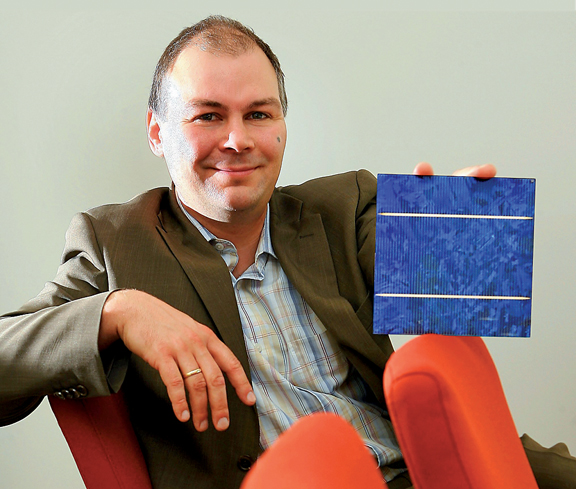Dr. Jorg Bagdahn surrounds himself daily with the keenest minds in photovoltaic research and development. He’s hoping that model replicates itself in similar choices by executives at world-leading solar energy manufacturing companies.
If the early returns of the Fraunhofer Center for Silicon Photovoltaics in Halle in Saxony-Anhalt, Germany, are any indication, then Bagdahn is well on his way to seeing his dream fulfilled.
As the head of the Center, Bagdahn oversees a research institute that is revolutionizing the way R&D is done in the photovoltaic sector. By spearheading research efforts that are producing greater-than-ever efficiencies in solar power conduction, Bagdahn and his team of scientists have positioned Saxony-Anhalt to remain the dominant global leader in solar energy technology.
“Photovoltaics supply 15,000 times more energy in one hour than is consumed in the world,” says Bagdahn. “We have to exploit this potential.”
Bagdahn, who at age 38 has already authored a doctoral dissertation on silicon, is now pursuing lower-cost and higher-efficiency solar energy through improvements in silicon crystal and solar module production.
The
The Center conducts research in the fields of silicon crystallization, thin-film technologies and the development of materials. Researchers at the institute manufacture and evaluate modules; they also carry out electrical, optical and micro-structural characterization of materials and components.
“At the end of 2006, we had at that time achieved the highest concentration of PV research and development in eastern
A plan was developed to build the research center in
A Lure to Top Scientists
Today,
“We have researchers who are coming from private industry and working in their field while they are here,” notes Bagdahn. “Some are coming from universities, and some are coming from other research institutes in
Bagdahn also facilitated an exchange program with the Massachusetts Institute of Technology in
“This is a non-profit research institute,” Bagdahn says. “The German government provides 25 percent of the institute’s annual support. We have to raise the other 75 percent. About half of that comes from direct contract research, and the rest comes from grants from various organizations.”
Students compete for selection to the center. “Together with a regional University and PV companies like Q-Cells and Sovello, we have one model for the students we choose to accept,” says Bagdahn. “They have to go first to a company, which selects the student and provides financial support. Then, after they finish the program at the University, they must go to work for that company.”
The result is a job placement rate of practically 100 percent.
Bagdahn says the major goal of the center is “to reach crystalline silicon area penetration in
The investments appear to be paying off. Today, more than 90 percent of all silicon solar cells made in
“In eastern
Q-Cells SE and Sovello, two of the largest solar cell manufacturing companies in the world, operate large production facilities in
Malibu GmbH & Co. KG has been granted official approval to begin production of a new type of thin-film solar module in Saxony-Anhalt.
Q-Cells, the largest European producer of solar cells, plans to reach total employment of 5,000 workers and expand its core business to more than 1 gigawatt of capacity by 2010.
Sovello, a joint venture of REC of
One more major establishment is coming from another Norwegian company. The cutting of the first sod for Vetro Solar in the middle of October marked the start of an investment of €23.5 million (US$34.7 million) and two new manufacturing halls for producing sheet glass.
Incentive Drives PV Market
“We are seeing interest in expansion activity in Saxony-Anhalt from solar energy manufacturing companies in
The main driver of the PV market in
The result of this legislation has been an unprecedented expansion in the German solar cell production sector and its supporting industries. German PV equipment manufacturers last year sold machinery worth €2.3 billion (US$3.4 billion).
Some 142 solar patents were registered in
“This is a very stable market. People are buying modules here,” says Bagdahn. “Companies are checking to see if they can build a factory here so that they can have a better connection to the local market.”
This editorial profile was published under the auspices of the Investment and Marketing Corporation of Saxony-Anhalt. For more information on investment opportunities in Saxony-Anhalt, contact Dr. Carlhans Uhle by phone at +49 (0) 391-568-9912 or by e-mail at carlhans.uhle@img-sachsen-anhalt.de. On the Web, go to www.invest-in-saxony-anhalt.de.
